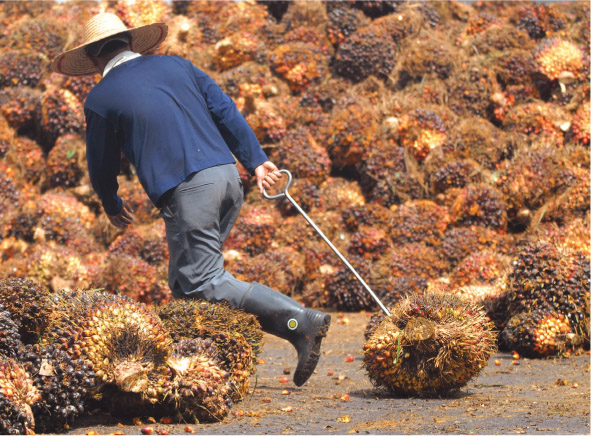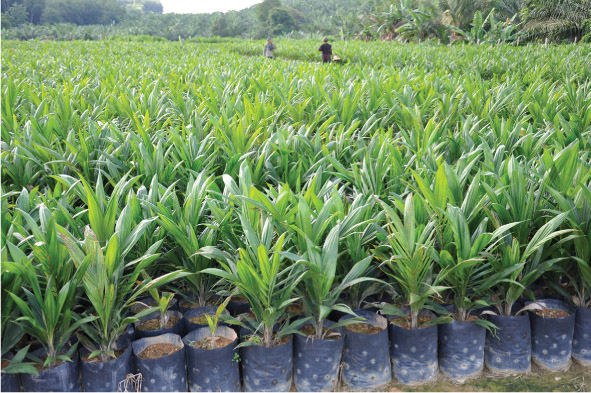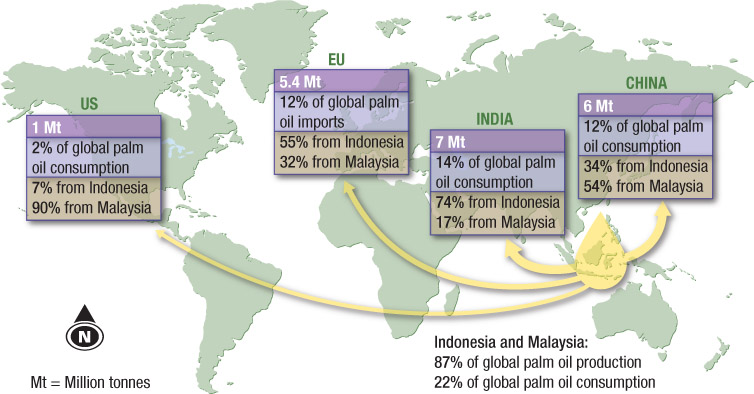7.6 Palm oil and responsible consumerism
Often we are not aware of the ingredients in the products we buy and therefore are ignorant of the environmental and social consequences of our purchases. Palm oil is one such ingredient.
Palm oil is found in many of the products we buy at the supermarket. These include cooking oil, chocolate, cosmetics, chips, instant noodles, biscuits, margarine, shower gel, shampoo and soaps.
What is palm oil?
Palm oil comes from the fruit of the Elaeis guineensis species of palm, which originates in the equatorial (between 10°N and 10°S of the Equator) coastal regions of West Africa. It has been used by humans for over 5000 years.

Palm oil has a high resistance to oxidation, and therefore to decaying, so it is used in the production of margarine, sweets and baked goods to increase their shelf life.
Palm oil contains a balanced mix of saturated and unsaturated fats and as a result is considered healthier than many other vegetable/plant oils, especially for people concerned about high cholesterol levels.
Palm oil is also a relatively stable product, and remains solid at room temperature (its melting point is 35°C); this makes it well suited for soap and similar products.
Because it originates in the wet equatorial region of West Africa, palm oil is ideally suited for growing in other equatorial regions of the world, especially in Southeast Asia. Four West African Deli Dura palm oil seedlings were planted in Buitenzorg’s (Java) botanic gardens in 1848. The descendants of these four seedlings became the breeding stock for the first commercial plantings in Indonesia and Malaysia in the early 1900s.
Southeast Asia has both a favourable growing environment and a lack of pests and diseases, so these plants produced oil that was superior in quality to that from West Africa.
Since the 1980s there has been a rapid increase in the production of palm oil, particularly in Indonesia and Malaysia, which together produce over 80% of the world’s palm oil.
DEVELOPING YOUR UNDERSTANDING 7.8
- If you can work it out, make a list, over one week, of all the products that contain palm oil that your family buys.
- At the end of the week share your list with the class and draw up a list of the top five products.
- Discuss your findings with your family or friends and find out if they knew that palm oil was used in so many products.

| Country | 2009 | % | 2010 | % | 2011* | % |
|---|---|---|---|---|---|---|
| Indonesia | 21.00 | 46.00 | 22.20 | 48.40 | 23.90 | 48.79 |
| Malaysia | 17.56 | 38.79 | 16.99 | 37.04 | 18.00 | 36.75 |
| Thailand | 13.10 | 3.00 | 1.34 | 2.92 | 1.45 | 2.96 |
| Nigeria | 0.87 | 1.90 | 0.89 | 1.93 | 0.90 | 1.84 |
| Colombia | 0.80 | 1.80 | 0.75 | 1.64 | 0.85 | 1.74 |
| Papua New Guinea | 0.48 | 1.00 | 0.50 | 1.09 | 0.53 | 1.08 |
| Ecuador | 0.43 | 0.90 | 0.36 | 0.78 | 0.40 | 0.82 |
| Cote d’Ivoire | 0.35 | 0.80 | 0.30 | 0.65 | 0.32 | 0.65 |
| Cameroon | 0.34 | 0.70 | 0.35 | 0.75 | 0.35 | 0.71 |
| Honduras | 0.28 | 0.60 | 0.28 | 0.60 | 0.29 | 0.59 |
| Costa Rica | 0.22 | 0.50 | 0.24 | 0.51 | 0.25 | 0.51 |
| Brazil | 0.24 | 0.50 | 0.25 | 0.54 | 0.27 | 0.55 |
| Others | 1.39 | 0.30 | 1.44 | 3.13 | 1.49 | 3.04 |
| World | 45.27 | 100.00 | 45.87 | 100.00 | 48.99 | 100.00 |
| * predicted production: the table was developed in 2011, before the figures were finalised. | ||||||
Environmental impacts
The expansion of palm oil production is leading to the clearing of the natural rainforest in large areas of Indonesia and Malaysia. The clearing of the forest usually also involves large wildfires and illegal logging operations.
This clearing is the major cause of deforestation in these countries. This deforestation results in a loss of habitat for animal and insect species and a reduction in plant biodiversity. The United Nations Environment Program (UNEP) has predicted that by 2022 the palm oil industry could wipe out 98% of Indonesia’s remaining rainforests.

The reduction of habitat in the southern Malaysian peninsula has resulted in an over 70% reduction in bird numbers, and in Indonesia it could result in the loss of the orang-utan and Sumatran tiger.
The extensive deforestation also has major climatic implications, as mature tropical rainforest acts as a store or sink of carbon. When the forest is burnt or logged, carbon dioxide is released into the atmosphere. As the life cycle of a palm oil plantation is very short (less than 30 years) compared with that of rainforests, plantations contribute to carbon emissions into the atmosphere rather than acting as carbon sinks.
The threats of deforestation and greenhouse emissions from oil palm plantations are so grave that the World Bank has now suspended lending to palm oil producers until safeguards are developed and implemented to ensure that such lending doesn’t cause further social or environmental harm.
Source 7.12a In Indonesia, indigenous species are being placed at risk as native forests are removed to make way for palm plantations. (02:56)
Social impacts
The destruction of the rainforests and the creation of large palm oil plantations, many of which are owned by transnational companies, has had a considerable impact on the lifestyle and rights of the people who have lived with the forests for hundreds, if not thousands, of years. Their sources of food have been removed and the use of pesticides and weedicides in the plantations has had adverse health effects, especially for those who work in the plantations.
The plantations have, however, improved the opportunities for employment in often very poor communities.
The certified oil debate
The exploitation of the traditional landowners and the natural environment has led to movements to establish ethical palm oil production methods. The establishment of the Roundtable on Sustainable Palm Oil (RSPO) in 2004 to promote more environmentally and socially sustainable palm oil products is a major step towards ethical palm oil production.
RSPO’s members include palm oil growers, palm oil processors and/or traders, consumer goods manufacturers, retailers, banks and investors, environmental/ nature conservation non-government organisations (NGOs) and social/ developmental NGOs. Note that the traditional owners of the land are not included.
It remains to be seen how well the RSPO will be able to meet the economic demands of the palm oil industry while at the same time reducing, even eliminating, social and environmental harm.

DEVELOPING YOUR UNDERSTANDING 7.9
- Describe the advantages of using palm oil.
- List the countries that are the major producers of palm oil.
- Identify the regions or countries that are the major consumers of palm oil.
- Describe the major environmental issues of the palm oil plantation industry.
- Explain what we can do to encourage environmentally and socially sustainable palm oil production.
